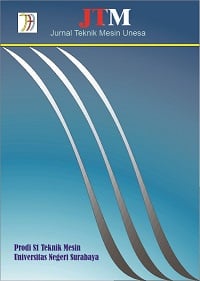PENGARUH VARIASI JARAK CELAH SUDU PENGGANGGU DENGAN SUDU UTAMA BERPENAMPANG PLAT DATAR TERHADAP KINERJA TURBIN CROSSFLOW
Abstract
The increasing number of people every year indirectly has an impact on energy consumption which is also increasing. This must be anticipated from now on by switching to alternative renewable energy. Micro hydro power plants utilize water energy in the local area to drive turbines that can produce electrical energy. Crossflow turbines are an alternative in the construction of micro hydro power plants (PLTMH) because crossflow turbines are classified as low head. The purpose of this study was to determine the effect of variations in the distance between the interfering blades and the main blade with a flat plate section on the performance of the crossflow turbine. This study uses an experimental method by varying the distance between the interfering blades and the main blade with a gap of 2cm, 4cm, 6cm, and without the interfering blades with a flat plate cross-section on a horizontal axis crossflow turbine. The number of blades used are 6 interfering blades and 6 main blades to be tested with variations in water capacity of 11,017 L/s, 14,313 L/s, 16,142 L/s, 18,102 L/s, and variations in loading as well. The result of this research is that the highest turbine power is produced by variations with the gap between the interfering blades and the main blade 6 cm, at a capacity of 18,1116 L/s at a loading of 4000 grams, amounting to 3,618 Watts. The highest efficiency is also produced by a turbine with a gap between the interfering blades and the main blade 6 cm, at a capacity of 11.0231 L/s at a load of 2000 grams, amounting to 75.63%.
Downloads
 Abstract views: 94
,
Abstract views: 94
, PDF Downloads: 200
PDF Downloads: 200


